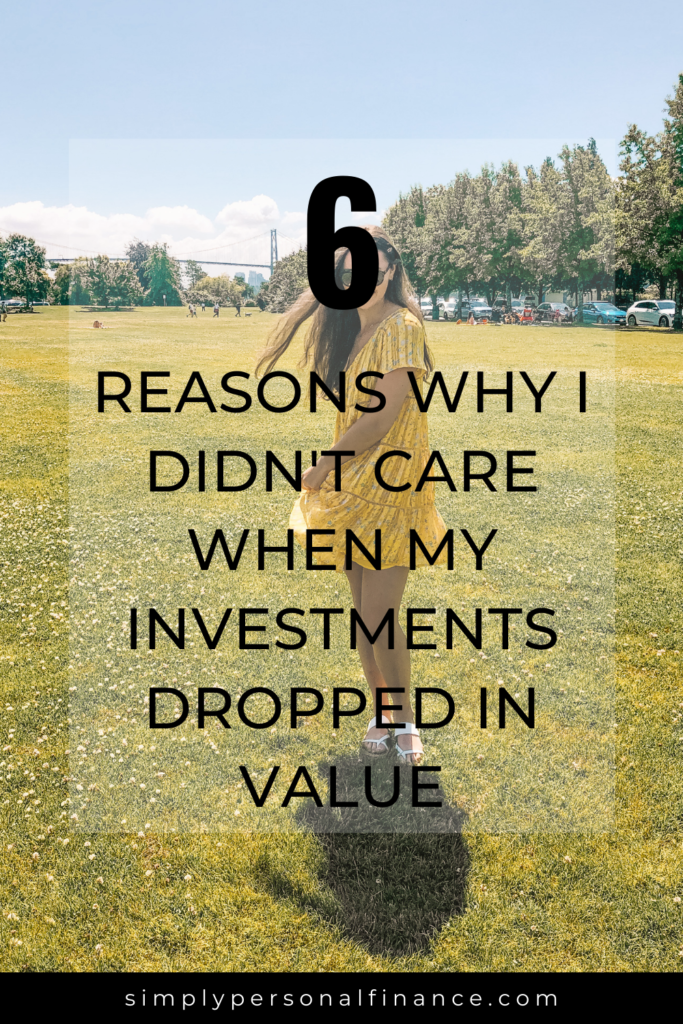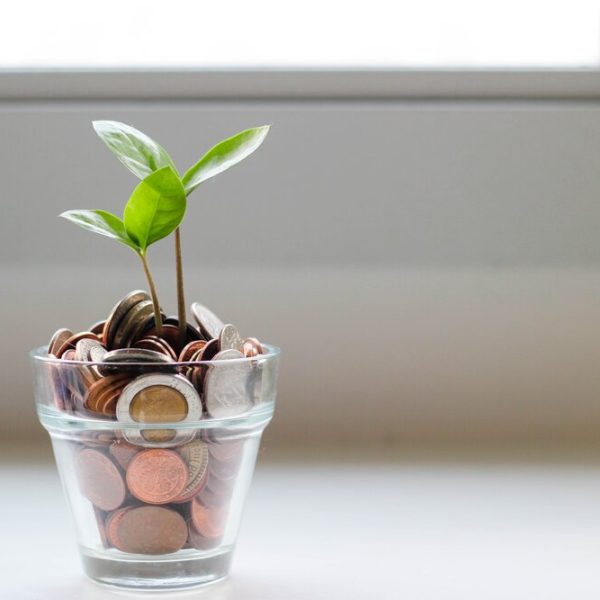From the Australia bushfires to the coronavirus pandemic, 2020 has been a crazy year to say the least. With businesses closing all around us and people being forced to stay home for public health and safety, a stock market crash was inevitable. So, why didn’t I care when my investment portfolio dropped in value?
While the market was plunging, a lot of investors may have felt the panic to sell their investments and get out while they could. The very idea of losing money is extremely anxiety inducing to most investors.
In this article, I hope to highlight why a market crash is not the time to be selling your investments and “cut your losses”. It is not the time to buy up bitcoin or move all of your investments into gold bars. While investing can be a serious emotional toll for many, here are a few reasons why I didn’t care when my investment portfolio dropped in value earlier this year. Hopefully, you’ll be able think more logically, less emotionally and stay the course of your investment plan during the next market hiccup.
Longterm Trends
For the record, I do not buy individual stocks. I invest in exchange-traded funds (ETFs). An ETF is a fund that holds hundred to thousands of individual stocks and its holdings are designed to track the market, not to beat it. To learn more about individual stocks and ETFs, check out the The Basics of Investing In Canada.
When the market starts to drop, I remind myself that historically, markets have always recovered and are extremely likely to recover once again. I invest in ETFs because they are extremely diversified investment products. If one company I’m invested in falls apart, I probably won’t even notice it because that’s just one company out of the hundreds or thousands that I’m invested in.
ETFs are designed to track the market, so if the market is falling, my portfolio will inevitable go down in value. But, if the market is growing, my portfolio will grow with it. Take a look at this graph below showing 100 years of historical data of the Dow Jones.
Dow Jones – DJIA – 100 Year Historical ChartSource: Dow Jones – DJIA – 100 Year Historical Chart
The Dow Jones is one of those stock market indexes that you might hear them mention on the news. It simply tracks the stock performance of the top 30 companies in the United States. Now this is just one example of one index and yes there are drops in the market index at some points. However, when looking at the overall trend line, it’s only up from here. If you’re able to stay the course and hold on during the downturns, you can make some great profits on the way back up. You don’t want to get scared, run away and lose out on those gains while the market is recovering. Stay strong!
FYI the longterm trends logic does not apply to mutual funds or individual stocks. You would need to have a large diversified portfolio of individual stocks (20+). If you’re interested in learning more about individual stocks and ETFs, check out the The Basics of Investing In Canada.
Shares Logic
The way I think about it, I haven’t actually lost any money unless I sell shares. As a buy and hold investor, I still have the same number of shares, they’ve simply decreased in value. On paper it may look like I’ve lost money but if I don’t cash out and sell my shares, I haven’t actually lost anything. If I keep calm and stay the course of my investment plan, as soon as the market turns around, my investments will be back up in value.
Sale Price Mindset
Imagine taking $500 to the mall on a regular day versus a boxing day sale. With 50% off sales all around you, your $500 will go a lot further. When you first arrived at the mall you might have been hoping to buy 2 pairs of pants and 2 jackets. However, noticing the markdown prices, you might now be able to buy 3 pairs of pants, 3 jackets and 2 sweaters. Nice!
Now imagine there’s a sale on bags of rice at the supermarket. You don’t see people getting stressed out and running away from the sale, do you? That would be ridiculous! No one is going to be upset that the rice has gone down in price, instead you’ll see people buying it up and stashing their cabinets full.
So what’s the moral of the story? If you regularly invest $500 each month, don’t stop just because you’re scared of losing money. Think of it as the stock market being on sale. You’ll now be able to buy more shares per dollar while the market is down. Don’t run away from the sale!
While we are young, we should honestly be jumping for joy that our investments are not making tons of money right away. Why? Because that means we’re able to buy them for a good price. We want to buy shares when they are lower in price and then hold them for a long time. Again, this is assuming you are invested in index funds and exchange-traded funds or a diversified portfolio of individual stocks. This trend does not apply to mutual funds or when looking at each stock individually!
Dollar Cost Averaging
The truth is, we are not always going to be able to time the market perfectly. We won’t always be able to buy stocks at the lowest price. This is why I love the principles of dollar cost averaging. Yes the overall idea of buying low and selling high is important but timing the market is a losing battle. Timing the market is difficult for most financial professionals, let alone regular investors like you and I.
Timing the market refers to a person trying to buy stocks at it’s lowest price just before it skyrockets. While this logic is important to think about in a general sense, timing the market is very difficult, if not impossible.
We can do our best not to sell stocks while our investments are down in value but it’s very hard to predict whether they are at a low or at a high. The market could drop 20% the next day or it could rise by the same amount and never fall again. We never really know until the next day comes. If it does rise, we might lose out on some of the best gains in the stock market because we were “waiting for the right time”.
Dollar cost averaging simply means that you are investing consistently no matter what the market is doing. I personally invest on the 1st and the 16th of the month, no matter what’s going on in the market. Sometimes I’ll buy on the high, sometimes I’ll buy on the low. Overall, I’m betting on the fact that I will average out over time. No timing the market, no big risks, just doing my best to be average. When it comes to investing, average is good. Scratch that, average is great!
One reason why I didn’t care when my investment portfolio dropped in value was because dollar cost averaging takes away the stress of buying and trading stocks. Dollar cost averaging makes investing much more simple. If your investments drop in value, no problem, just keep on investing.
Risk Tolerance
At the end of the day, it’s important to remember your why. What is the end goal with your investment portfolio? Retirement? Saving up to purchase your dream home? Always refer back to why you started in the first place. Remember the longterm trends and stay strong.
I will admit, I have a high risk tolerance when it comes to investing. All of the points mentioned in this article have helped me stay calm during the 2020 market crash. But, you probably know yourself better than I do. Do you completely freak out at the thought of losing a few hundred or a few thousand dollars? Even when you know the market has always historically recovered and risen again? Be honest with yourself.
As investors, we should only be investing money that we are mentally prepared not to see or use for 10+ years. I personally hope to use a large portion of my investment portfolio for a downpayment in less than 10 years time but that’s not absolutely necessary. It’s not a life or death situation if I have to wait a few years to buy a home. I am mentally prepared not to use the money in my investment accounts for many many years if need be. Time is our friend here.
If you are scared to lose even a penny of your investment portfolio at any given time, you might want to consider working with a third party like a roboadvisor or a professional fee-only investment advisor. Having a third-party will help you stay the course of your investment plan and not react out of fear. You might also want to look into a safer and less volatile investment portfolio. This way, so investing journey is not as much of a rollercoaster ride. Less risk, less reward, but if you can sleep better at night, that may be the best choice for you.
Have A Plan
Another reason why I didn’t care when my investment portfolio dropped in value was because I had a plan. A great way you can achieve some piece of mind is to have an emergency fund. An emergency fund is generally 3-6 months of expenses (or whatever you personally feel comfortable with). These funds should be very easily accessible while still racking up interest in a high interest savings account, not in an investment account. If times get tough, you can reach for your emergency fund instead of selling your investments at a loss.
Make a plan to follow and stick to it, even when times get tough. The best thing to do is to make decisions while everything is going according to plan. Then, when a stressful situation comes out of nowhere (hi covid-19!), you can avoid making decisions out of fear.
“So smile when you read a headline that says ‘Investors lose as market falls.’ Edit it in your mind to ‘Disinvestors lose as market falls—but investors gain.’ Though writers often forget this truism, there is a buyer for every seller and what hurts one necessarily helps the other.”
-Warren BUffet
Disclaimer: I am not a certified financial planner or investment advisor. The ideas posted on this website are my own opinions on how I manage my personal finances. The content is specifically for educational and informational purposes and is not considered professional financial advice. Everyone’s finances work differently and you will have to do your own due diligence before making any financial decisions.
Pin it for later!









Fear is absolutely not a driving factor with investments. You clearly outline how to organize investing so that it is not done from an emotional state but a logical plan. I enjoyed reading this article. Thank you.